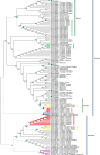Genetic diversity and phylogenetic analysis of Tams1 of Theileria annulata isolates from three continents between 2000 and 2012
- PMID: 26155166
- PMCID: PMC4439959
- DOI: 10.5114/ceji.2014.47732
Genetic diversity and phylogenetic analysis of Tams1 of Theileria annulata isolates from three continents between 2000 and 2012
Abstract
Theileria annulata, which is part of the Theileria sergenti/Theileria buffeli/Theileria orientalis group, preferentially infects cattle and results in high mortality and morbidity in the Mediterranean, Middle East, and Central Asia. The polypeptide Tams1 is an immunodominant major merozoite piroplasm surface antigen of T. annulata that could be used as a marker for epidemiological studies and phylogenetic analysis. In the present study, a total of 155 Tams1 sequences were investigated for genetic diversity and phylogenetic relationships through phylogenetic analysis. Results showed that the Tams1 sequences were divided into two major groups and that distribution for some isolates also exhibited geographic specificity. As targeting polymorphic genes for parasite detection may result in underestimation of infection, polymerase chain reaction (PCR) assay using two different probes targeting tams-1 genes of these two groups can be more credible. In addition, the direction of the spread of the disease was discovered to be from the Mediterranean or the tropical zone to the Eurasian peninsula, Middle East, Southern Asia, and Africa, particularly for Group 2. A similar occurrence was also found between the Ms1 gene of Theileria lestoquardi and the Tams1 gene of T. annulata, which explains cross-immunogenicity to a certain extent. However, no potential glycosylation site in the Tams1 of T. annulata was found in this study, which illustrated that instead of N-glycosylation, other modifications have more significant effects on the immunogenicity of the Tams1 protein.
Keywords: Tams1; Theileria annulata; genetic diversity; phylogenetic analysis; three continents.
Figures
Similar articles
-
Molecular Epidemiology and Genotypic Diversity of Theileria annulata among Bovines Based Upon Tams1 Gene in India.Acta Parasitol. 2025 Apr 3;70(2):81. doi: 10.1007/s11686-025-01014-1. Acta Parasitol. 2025. PMID: 40178641
-
Selection of diversity at putative glycosylation sites in the immunodominant merozoite/piroplasm surface antigen of Theileria parasites.Mol Biochem Parasitol. 1995 Jun;72(1-2):149-62. doi: 10.1016/0166-6851(95)00074-b. Mol Biochem Parasitol. 1995. PMID: 8538686
-
Revisiting the Tams1-encoding gene as a species-specific target for the molecular detection of Theileria annulata in bovine blood samples.Ticks Tick Borne Dis. 2013 Feb;4(1-2):72-7. doi: 10.1016/j.ttbdis.2012.07.006. Epub 2012 Dec 11. Ticks Tick Borne Dis. 2013. PMID: 23246094
-
Immunity and vaccine development in the bovine theilerioses.Adv Parasitol. 1999;44:41-97. doi: 10.1016/s0065-308x(08)60230-4. Adv Parasitol. 1999. PMID: 10563395 Review.
-
Theileria lestoquardi displays reduced genetic diversity relative to sympatric Theileria annulata in Oman.Infect Genet Evol. 2016 Sep;43:297-306. doi: 10.1016/j.meegid.2016.05.007. Epub 2016 May 7. Infect Genet Evol. 2016. PMID: 27166095
Cited by
-
Discovery of a new Theileria sp. closely related to Theileria annulata in cattle from Sri Lanka.Sci Rep. 2019 Nov 6;9(1):16132. doi: 10.1038/s41598-019-52512-y. Sci Rep. 2019. PMID: 31695080 Free PMC article.
-
Epidemiological situation of bovine tropical theileriosis in an arid region in central Tunisia with a phylogenetic analysis of Theileria annulata.Vet Med Sci. 2023 Nov;9(6):2862-2870. doi: 10.1002/vms3.1276. Epub 2023 Sep 19. Vet Med Sci. 2023. PMID: 37725348 Free PMC article.
-
Genetic Profiling Reveals High Allelic Diversity, Heterozygosity and Antigenic Diversity in the Clinical Isolates of the Theileria annulata From India.Front Physiol. 2019 Jun 7;10:673. doi: 10.3389/fphys.2019.00673. eCollection 2019. Front Physiol. 2019. PMID: 31231237 Free PMC article.
-
Epidemiology, haematology and molecular characterization of haemoprotozoon and rickettsial organisms causing infections in cattle of Jammu region, North India.BMC Vet Res. 2021 Jun 15;17(1):219. doi: 10.1186/s12917-021-02915-9. BMC Vet Res. 2021. PMID: 34130708 Free PMC article.
-
Molecular Epidemiology and Genotypic Diversity of Theileria annulata among Bovines Based Upon Tams1 Gene in India.Acta Parasitol. 2025 Apr 3;70(2):81. doi: 10.1007/s11686-025-01014-1. Acta Parasitol. 2025. PMID: 40178641
References
-
- Santos M, Soares R, Costa P, et al. Revisiting the Tams1-encoding gene as a species-specific target for the molecular detection of Theileria annulata in bovine blood samples. Ticks Tick Borne Dis. 2013;4:72–77. - PubMed
-
- Elsify A, Sivakumar T, Nayel M, et al. An epidemiological survey of bovine Babesia and Theileria parasites in cattle, buffaloes, and sheep in Egypt. Parasitol Int. 2014 [Epub ahead of print] - PubMed
-
- Meng K, Li Z, Wang Y, et al. PCR-based detection of Theileria annulata in Hyalomma asiaticum ticks in north-western China. Ticks Tick Borne Dis. 2014;5:105–106. - PubMed
-
- Gubbels MJ, Katzer F, Hide G, et al. Generation of a mosaic pattern of diversity in the major merozoite-piroplasm surface antigen of Theileria annulata. Mol Biochem Parasitol. 2000;110:23–32. - PubMed
-
- Gharbi M, Darghouth MA, Weir W, et al. Prime-boost immunisation against tropical theileriosis with two parasite surface antigens: Evidence for protection and antigen synergy. Vaccine. 2011;29:6620–6628. - PubMed
LinkOut - more resources
Full Text Sources
Other Literature Sources
Research Materials



